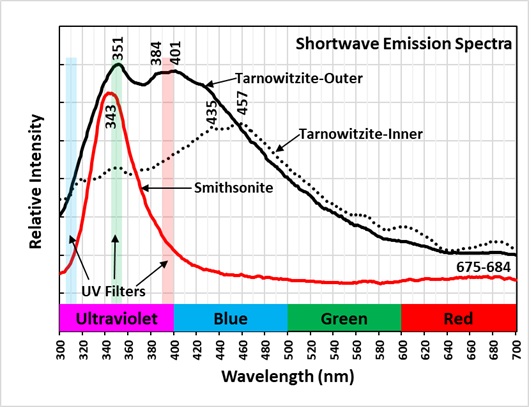Tarnowitzite and Smithsonite from Tsumeb, Namibia
Contributed by: Michael Crawford
Date: Jul 30th, 2025
Locality: Tsumeb Mine (Ongopolo Mine), Tsumeb, Oshikoto Region, Namibia (See on Mindat)
Size: 7.5 x 8.5 cm
Description:
White tarnowitzite crystals on a bed of honey brown smithsonite crystals from Tsumeb, Namibia. The smithsonite was deposited on a base of calcite. Tarnowitzite is a lead rich variety of aragonite. The tarnowitzite crystals exhibit zoning that is best seen in the images of fluorescence. The outer rim of the tarnowitzite crystals is fluorescent under all wavelengths of UV light and its fluorescence color changes from yellowish white under longwave UV light to white under shortwave light. The fluorescence of the outer rim is also much brighter than the cores of the crystals. The crystal cores change color from blue gray under longwave UV light to yellowish white under shortwave UV light.
The smithsonite and calcite only fluoresce under shortwave UV light. The smithsonite fluoresces red and the calcite is orange red. The smithsonite is non-reactive to acid and the calcite effervesces from a drop of acid.
Emission spectra show that tarnowitzite and smithsonite also have ultraviolet fluorescence. The fluorescence of the outer rims of the tarnowitzite have peaks at 351 nm, 384 nm and 401 nm. Lead is a possible activator, but this needs to be confirmed. The core of the tarnowitzite crystals has dimmer ultraviolet fluorescence. It retains a small peak at 351 nm, but the peaks at 384 nm and 401 nm are gone. The spectrum peaks in the visible at 457 nm with a secondary peak at 435 nm. It is unknown what the activator is for this fluorescence.
The smithsonite spectrum has a single peak with a maximum at 343 nm and the intensity is significantly greater than its red visible fluorescence. It is unknown what activates this ultraviolet fluorescence as well as the red fluorescence that is a broad peak with a maximum around 675 nm to 685 nm.
The calcite shortwave fluorescence is weak, and its emission spectrum is very noisy. There are two peaks, one around 615 nm that is from manganese activation and another 680 nm. This 680 nm peak may be from intermixed smithsonite.
The last image shows ultraviolet fluorescence. It is a false color image composed of three 10 nm narrow bandpass images with filters centered at 310 nm, 350 nm and 394 nm. These filters are shown in the plots of emission spectra. The bright fluorescence of the smithsonite at 343 nm is shown as green in the false color image. The outer rim of the tarnowitzite has a yellow-brown color because of its bright fluorescence at 351 nm and around 390nm. The cores of the tarnowitzite are brown. The calcite has no ultraviolet fluorescence, so it is black in the false color image.
Summary of luminescence responses:
Tarnowitzite (Mindat) (RRUFF)
- Fluorescence under Longwave (365nm LED) UV light: White
- Fluorescence under Shortwave (255nm LED) UV light: White
- Fluorescence under Shortwave (255nm LED) UV light: Red






